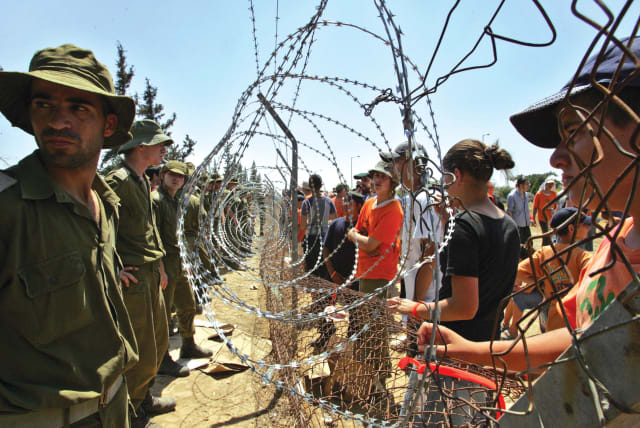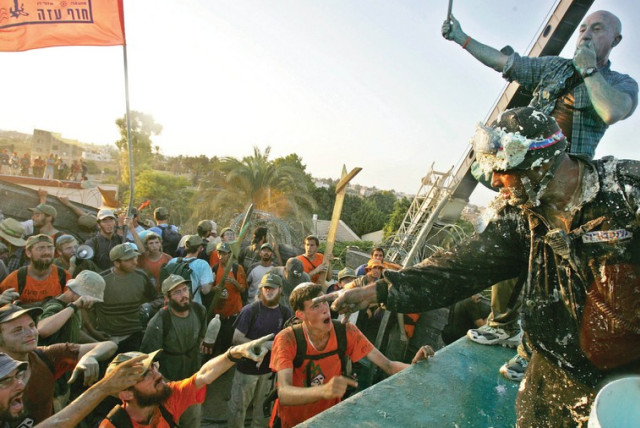Post-trauma response: The growing trend of wanting to return to Gaza

There have been many initiatives in the past 19 years to reestablish Jewish communities in the Gaza Strip, but until the October 7 massacre by Hamas, it didn't look likely.
Hanan Ben Ari, one of Israel’s leading singers, sang one of his first hit songs this week and symbolized a deep but growing trend. The song, “Ima Im Hayiti,” (Mother, If Only I Could), was written after the Disengagement from the Gaza Strip in 2005, when the Gush Katif settlements there were dismantled.
Ben Ari, who grew up in Samaria as a member of a prominent religious-Zionist family, is considered to be in the mainstream of the Israeli pop scene. He stars in commercials for El Al and other large companies. He was criticized by some for hinting, in a performance a few days ago, that Israel should reconquer Gaza – he repeated one of the more powerful sentences in the aforementioned song, “You promised that someday we’ll come back here,” meaning, to Gush Katif.
There have been many initiatives in the past 19 years to reestablish Jewish communities in the Gaza Strip, but until the October 7 massacre by Hamas, most of those activists involved weren’t sure it would actually happen.
Missing Gush Katif
In the ever-changing landscape of the Middle East, few voices remain as deeply affected by, and intricately connected to, the past as that of Meir Dana-Picard, a former resident of Gush Katif. Once a young manager at the Chasalat, a vegetable packing house in the region, today Dana-Picard embodies the memories, aspirations, and uncertainties of those who once called Gush Katif home.
Recounting his earlier days, Dana-Picard said, “My wife and I, fresh into our marriage at 24, decided to make Gush Katif our home.”
Now living in Beit Hagai, in the South Hebron Hills, with a bustling family of 12 children, he has leveraged the power of social media to ensure that the story of Gush Katif remains alive. “During Operation Protective Edge about a decade ago, I felt the need to initiate a dialogue, which led me to start our Facebook page, called ‘Home – returning to the Gaza Strip.’ It became a beacon for many, discussing various events and happenings over the years.” This page has close to 9,000 followers, and since the Hamas massacre, it has been more active than ever before.
The emotional toll of witnessing the area’s transformation is evident in Dana-Picard’s voice. Drawing a poignant parallel, he remarked, “The sensation is reminiscent of the prophet Jeremiah, who bore witness to prophesied events. Our pain runs deep, extending to every resident who suffered during the unfortunate events, and not forgetting the soldiers.”
Dana-Picard further elaborated on the tumultuous nature of the Strip, noting that unrest has been a constant companion since the Israeli Disengagement. But amid the turmoil, there have been silver linings. One such beacon of hope is establishing a group, aptly named Garin Kfar Darom (core group).
“Our goal is to represent the aspirations and dreams of the younger generation of Kfar Darom,” said Dana-Picard. “We hold annual meetings, engaging in constructive dialogues with politicians and discussing the potential return to the region.”
The future of settlements
The future of settlements, according to Dana-Picard, needs a modern approach. “Our methodology has to evolve. Settlements may not look like they used to. Perhaps we should reconsider the current barriers and imagine an Israel that seamlessly stretches to the sea,” he proposed.
Highlighting the evolving political and social narratives, Dana-Picard expressed that sentiments once deemed radical are slowly becoming mainstream. He reflected on the controversial opinions surrounding figures like Ben Ari and added, “The criticisms are coming from more extremist viewpoints, but mainstream ideologies are shifting.”
On a deeply personal note, Dana-Picard expressed a burning desire to return to his roots. “The thought of going back to Gush Katif never leaves me. With 12 children and established lives, it’s a challenge. But the heart yearns, and I believe that one day, we will be back,” he affirmed.
IN THE Disengagement, Israel voluntarily removed 21 of its settlements from the Gaza Strip, relocating settlers and withdrawing its military from the region.
This initiative, known as the Disengagement Plan, was first introduced by prime minister Ariel Sharon in 2003. The government gave its nod in June 2004, and the Knesset ratified it as the Disengagement Plan Implementation Law in February 2005. By August, the plan went into effect, and by September of the same year, the entire process was completed. Settlers who did not choose to leave by the August 15, 2005, deadline despite being offered compensation, were removed by Israeli security forces. All inhabitants were evacuated, their homes demolished, and security forces pulled out from the Gaza Strip by September 2005. Following this, a similar process took place in four settlements in the northern West Bank. A total of 8,000 Jewish settlers from the Gaza settlements were moved, with each family receiving compensation averaging over $200,000.
While the United Nations and various international human rights bodies, along with some legal experts, believe that Israel continues to militarily occupy the Gaza Strip, this stance is contested by Israel and other legal authorities. After the withdrawal, Israel retains control over several of Gaza’s key aspects, including its airspace, maritime domain, the majority of its land crossings, and other vital resources. The region still depends on Israel for necessities like water, power, and communication.
The historical narrative of the Middle East is intricate, with the memories and ambitions of communities such as Gush Katif and northern Samaria being integral to the broader story. Motti Bachar, the CEO of the Gush Katif Heritage Center and Samaria Memorial Center, spoke with The Jerusalem Post about the complexities faced by the residents of these regions.
“We’re currently grappling with a deeply painful situation. We mourn our fallen and pray for those missing. Our center is focused on commemorating Gush Katif and northern Samaria – areas that were evacuated. We trace the settlement history in the Gaza Strip back to the era of [David] Ben-Gurion in the 1920s, who recognized the significant potential of this region.”
He expressed nostalgia for a time when national boundaries seemed more fluid. “Initially, it was all part of the State of Israel. Kfar Darom, founded in 1946, was one of 11 key points. By 1977, we had established 21 settlements. Our mandate revolves around preserving this rich heritage, understanding our past and present, and determining the communities’ future trajectory.”
Bachar’s commitment to his homeland is palpable. “We’ve resettled in other areas of Israel and continue to be deeply intertwined with the people of Israel. To many, Gaza remains a part of the State of Israel. It represents our ancestral heritage. The aspiration to return and resettle is ever present. However, any decision to return to Gush Katif should be based on a national consensus. If the majority of Israelis think that Israel should resettle the Gaza Strip, then we should do it; if it’s not a consensus, this isn’t something we would promote.”
Reflecting on the relationships between Israelis and Gazans, he remarked, “While we’ve erected some of the world’s most sophisticated barriers, they haven’t been the solution. We employed 3,300 Gazan workers in our greenhouses. We shared in each other’s joys and sorrows. The camaraderie began to wane during the First Intifada. Nonetheless, the support for our Gazan employees continued even after the Disengagement, through food, clothing, and other essentials. Some Jewish settlers still maintain connections with Gazans, staying updated on the well-being of their former employees.”
Bachar conveyed a concerning observation: “Hamas wasn’t very active when we were present. Since our departure, it seems we inadvertently strengthened Hamas. They began to exert more control, destabilizing the preexisting societal fabric.”
Highlighting the neutral stance of his organization, Bachar emphasized, “Our primary role is to educate about our history, without promoting any specific agenda. When and if the people of Israel choose to return, we’ll be supportive, but the decision isn’t ours to make. Our legacy and ongoing work persist. We are a governmental institution, not a private one. We remain optimistic about better days ahead, where we might see the revival of settlements in the region, including those in Gush Katif. Even those advocating for our departure from Gaza believed it would usher in peace with the Palestinians. However, the reality underscores that we are, at heart, good neighbors who deeply care for one another.”
A return to Gush Katif is far from being an actual plan, but it seems that since October 7, the voices calling for such a return have become more vocal. Signs with the message “Return to Gush Katif” have been hung up around the country, and graffiti has appeared with the same message. If there ever was a moment since 2005 that there would be a chance to rebuild Jewish settlements in the Gaza Strip, it’s now.
Jerusalem Post Store
`; document.getElementById("linkPremium").innerHTML = cont; var divWithLink = document.getElementById("premium-link"); if (divWithLink !== null && divWithLink !== 'undefined') { divWithLink.style.border = "solid 1px #cb0f3e"; divWithLink.style.textAlign = "center"; divWithLink.style.marginBottom = "15px"; divWithLink.style.marginTop = "15px"; divWithLink.style.width = "100%"; divWithLink.style.backgroundColor = "#122952"; divWithLink.style.color = "#ffffff"; divWithLink.style.lineHeight = "1.5"; } } (function (v, i) { });

